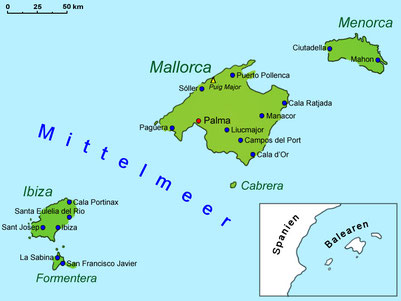Balearic Islands
Start / Destinations / Balearic Islands
The Balearic Islands
![[Translate to English:] Logo Spanien [Translate to English:] Logo Spanien](/fileadmin/_processed_/6/d/csm_spanien_aa734db5f5.gif)
No sailing destination is more versatile and adaptable than the Balearic Islands, located in the Mediterranean. The Balearic Islands are approximately a three-hour flight from Munich or Vienna. Palma de Mallorca, where the international airport is located, serves as a convenient starting point. Situated off the eastern coast of Spain, the island formation consists of four main islands: Mallorca, Menorca, Ibiza, and Formentera, along with smaller islands such as Cabrera, Espalmador, and Isla Dragoneras.
The best time for a sailing trip to the Balearic Islands is from May to September, when the weather is warm and sunny, and the winds are moderate. Outside temperatures range between 25°C and 35°C, while water temperatures range from 20°C to 26°C. These conditions provide ideal settings for relaxed sailing and exploring the coves and beaches of the Balearic Islands.
Highlights along the Sailing Route
Ibiza: Renowned for its vibrant nightlife, Ibiza also boasts tranquil beaches, crystal-clear waters, and the charming old town of Dalt Vila, a UNESCO World Heritage site. Beyond the party hotspots, you can explore idyllic coves like Cala Comte and Cala d'Hort or wander through the picturesque streets of Ibiza Town.
Mallorca: Explore the breathtaking coastline with hidden coves, dramatic cliffs, and picturesque beaches such as Es Trenc and Cala Mondragó. Don't miss the historic city of Palma with its impressive cathedral and lively cultural scene.
Menorca: Known for its peaceful atmosphere, Menorca offers pristine beaches like Cala Macarella and Cala Mitjana, as well as the historic city of Ciutadella with its beautiful architecture and rich history. Menorca is also a paradise for nature lovers, with numerous hiking and biking trails winding through the picturesque landscape.
Formentera: Famous for its crystal-clear waters and white sandy beaches like Playa de Ses Illetes and Playa de Llevant, Formentera is the perfect place to relax and enjoy the natural beauty of the Mediterranean - ideal for snorkeling and diving.
Cabrera Archipelago: This island group is home to diverse wildlife and offers breathtaking underwater landscapes. On the main island of Cabrera, you can visit the old fortress and explore the visitor center, which provides insights into the rich history and ecosystem of the archipelago.
In addition to cultural highlights and excellent sailing conditions, the Balearic Islands also offer a variety of cuisine and activities that will make your sailing vacation unforgettable:
Diverse Cuisine: Originally from Valencia, paella is also very popular in the Balearic Islands. There are many variations, including seafood paella, mixed paella with meat and seafood, and vegetarian paella. Tapas are a variety of small dishes perfect for sharing. Popular tapas include Patatas Bravas (fried potatoes with spicy sauce), Albóndigas (meatballs), and Pimientos de Padrón (small fried peppers). Ensaimada is a sweet, spiral-shaped pastry dusted with powdered sugar. It can be enjoyed plain or filled with pumpkin jam, chocolate, or cream.
Balearic Spirits and Wines: The traditional herbal liqueur, Hierbas, is a perfect blend of herbs and anise. There are many regional variations, and it is often enjoyed as a digestif after meals. Gin Xoriguer is a famous gin from Menorca, often served with lemonade as a "Pomada." Wine lovers can enjoy numerous Vino Tintos from local wineries. Especially on Mallorca, with its growing wine industry, many excellent wines can be discovered.
Parties and Festivals in the Balearic Islands: Sant Joan (St. John's Eve) is celebrated mainly on Menorca on the night of June 23rd. The festivities include fireworks, bonfires, traditional dances, and spectacular horse parades. The streets fill with locals and visitors celebrating the summer solstice. On the same day, Mallorca celebrates the Nit de Sant Joan, the Night of Fire and Water. Traditionally, people jump over bonfires and bathe in the sea to cleanse themselves and welcome the new year. The disco parties in Ibiza are world-famous and guarantee an exciting nightlife. Legendary clubs like Pacha, Amnesia, and Ushuaïa attract partygoers from around the world. These discos offer top DJs, spectacular shows, and an unparalleled atmosphere that makes Ibiza the party capital of the Mediterranean.
Mallorca, Menorca, Ibiza, and Formentera are just waiting to be explored during your sailing vacation.
We're happy to accommodate your individual preferences and tailor the perfect sailing itinerary for you, so you too can soon breathe in the scent of pine, spices, and sea salt.
Book your next dream vacation with the Holiday Planner today!
General Information
- Area: 4.992 km²
- Population: 1,1 Mio.
- Capital: Palma de Mallorca
- Languages: Spanish, Catalan
- Foreign Languages: German, English
- Currency: € Euro
- Ideal Travel Season: April - October
- Religion: Catholic. Minorities include Muslims, Jews, Protestants, and Hindus





